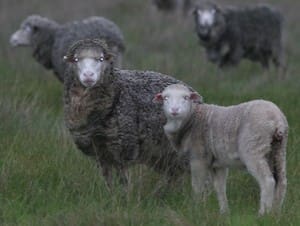
Merino ewes and lambs.
North central Victorian wool grower Ken Calder at Wareek is concerned that despite indications more sheep are being retained to rebuild flocks, insufficient Merino ewes are being bred to Merino rams to sustain quality wool production.
Australian shorn wool production in 2016/17 is forecast to lift 4.3 percent to 339 million kilograms greasy, mainly due to seasonal conditions lifting fleece weights, but Australian Bureau of Statistics figures show the number of farm businesses with sheep and presumably producing wool declined by at least 11 percent in the four years to June 30 2015.
The ABS does not routinely produce statistics on the number of farms producing wool. However, according to the bureau there were 39,512 agricultural businesses with sheep at June 30 2015 that had an estimated value of agricultural operations of more than $5000. In 2013-14, there were 40,897 agricultural businesses with sheep and in 2010-11 there were 43,828. Based on ABARES farm surveys, the number of these businesses that actually produce wool is estimated to be about 2pc lower as some farms only run sheep that are not shorn, such as Dorpers.
The most recent available ABS figures also show that at June 30 2015 there were 26.81 million Merino ewes aged one year and over in Australia and 12.5 million ewes of other breeds. Merino ewes mated to Merino rams totalled 16.3 million. In 2010-11, this number was 17.4 million. So over this four year period the number of ewes mated to Merino rams dropped by 7.1pc.
Click here to get Sheep Central story links sent to your email inbox.
Merinos to hit the wall – Ken Calder
Wool prices have risen to sustainable levels, but a major crisis is looming for the Merino industry.
This is being caused by the fall in numbers of Merino ewes joined to Merino rams which is unsustainable given the number of merinos used to breed first cross and terminal sire fat lambs.
With our national flock now down from a high of 176 million to 73 million the number required to sustain the numbers for replacements and crossbreed production is 25 million Merino breeding ewes. Currently only 18 million are being joined for pure Merino lambing. Divide that figure by half to allow for males and then by average lambing percentage then easy to figure out Merinos will need to be kept for many more years than current culling rates allow. While the statistics produced by ABARES show the numbers; either Australian Wool Innovation have not done the sums or they are keeping this information from producers and buyers.
What dampened the wool market from reaching higher levels recently was the amount of wool kept either in store or in sheds or from sheep shorn earlier which hit the market during the recent higher prices. Wool buyers best not believe that wool will keep flowing onto auctions at the same rate because they will be bitterly disappointed.
For many years, buyers have had an oversupply working in their favour; failing to pay a sustainable price when compared with alternative farming enterprises, but the wheel is turning and a supply of top quality wool will become very scarce. The main factor causing this is the comparative returns from meat sheep and the desire of the next generation to work from a tractor seat.
While we have lost one generation, the one now taking up the role is not prepared to work like peasants and for a peasant rate of returns, so they are opting to enjoy life away from dedicated arduous work and the harsh climatic conditions that a farming career in Australia presents. It’s much easier to press a button to activate the GPS tracking and leave all the gates open.
The amount of capital required to be a farmer nowadays is also a great deterrent. The dedicated sheep farmers are now an ageing part of the primary producer population, who as they retire, so do their Merino sheep flocks, taking with them the wealth of knowledge and experience these dedicated sheep men possess.
An analogous situation played out in Singapore, whereby that country lost all food production when peasant farmers encouraged their children into more lucrative employment and they sold off all the good highly productive land which ended up under highways and high rise housing. Australia cannot ride on the sheep’s back without Merinos.
Ken Calder, ‘Woodlands’, Wareek.
Editor’s note: The decline in Merino ewe numbers has been highlighted in several industry presentations by AWI, consultant Jason Trompf and at the World Merino Insight Conference last year when the Australian Association of Stud Merino Breeders launched its Breed More Merino Ewes campaign.
See links below to ewe flock and joining tables from a presentation by AWI’s Dr Paul Swan in July 2016 on Australian sheep flock demographics changes over the last 10 years.
Click here for changes in the ewe flock breed balance since 2000.
Click here for ewe type joining and marking percentage details.



HAVE YOUR SAY